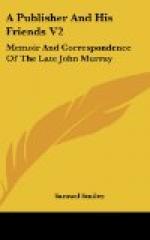This letter was accompanied with a heavy bill for printing the works of De Foe for Mr. Murray. A breach thus took place with the Ballantynes; the publisher of the Quarterly was compelled to look out for a new agent for Scotland, and met with a thoroughly competent one in Mr. William Blackwood, the founder of the well-known publishing house in Edinburgh.
To return to the progress of the Quarterly. The fifth number, which was due in February 1810, but did not appear until the end of March, contained many excellent articles, though, as Mr. Ellis said, some of them were contributed by “good and steady but marvellously heavy friends.” Yet he found it better than the Edinburgh, which on that occasion was “reasonably dull.”
It contained one article which became the foundation of an English classic, that of Southey on the “Life of Nelson.” Of this article Murray wrote to its author:
“I wish it to be made such a book as shall become the heroic text of every midshipman in the Navy, and the association of Nelson and Southey will not, I think, be ungrateful to you. If it be worth your attention in this way I am disposed to think that it will enable me to treble the sum I first offered as a slight remuneration.”
Mr. Murray, writing to Mr. Scott (August 28, 1810) as to the appearance of the new number, which did not appear till a month and a half after it was due, remarked on the fourth article. “This,” he said, “is a review of the ‘Daughters of Isenberg, a Bavarian Romance,’ by Mr. Gifford, to whom the authoress (Alicia T. Palmer) had the temerity to send three L1 notes!” Gifford, instead of sending back the money with indignation, as he at first proposed, reviewed the romance, and assumed that the authoress had sent him the money for charitable purposes.
Mr. Gifford to Miss A.T. Palmer.
“Our avocations leave us but little leisure for extra-official employment; and in the present case she has inadvertently added to our difficulties by forbearing to specify the precise objects of her bounty. We hesitated for some time between the Foundling and Lying-in Hospitals: in finally determining for the latter, we humbly trust that we have not disappointed her expectations, nor misapplied her charity. Our publisher will transmit the proper receipt to her address.”
One of the principal objections of Mr. Murray to the manner in which Mr. Gifford edited the Quarterly was the war which he waged with the Edinburgh. This, he held, was not the way in which a respectable periodical should be conducted. It had a line of its own to pursue, without attacking its neighbours. “Publish,” he said, “the best information, the best science, the best literature; and leave the public to decide for themselves.” Relying on this opinion he warned Gifford and his friends against attacking Sydney Smith, and Leslie, and Jeffrey, because of their contributions to the Edinburgh. He thought that such attacks had only the effect of advertising the rival journal, and rendering it of greater importance. With reference to the article on Sydney Smith’s “Visitation Sermon” in No. 5, Mr. George Ellis privately wrote to Mr. Murray:




